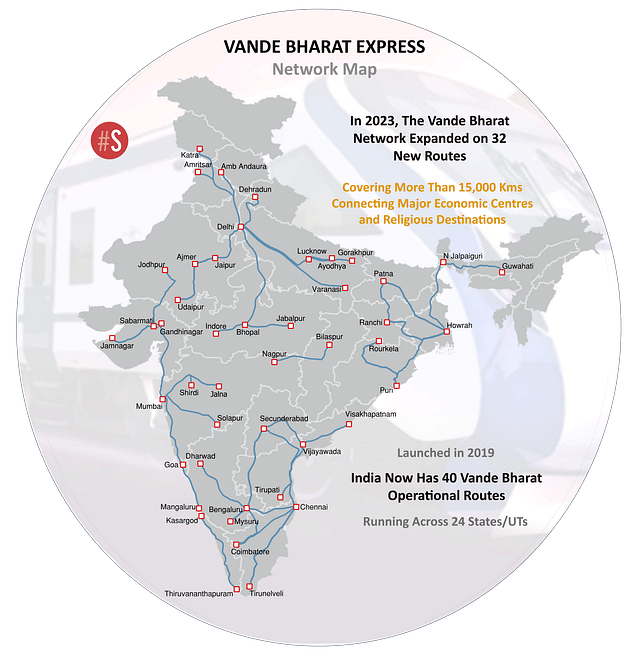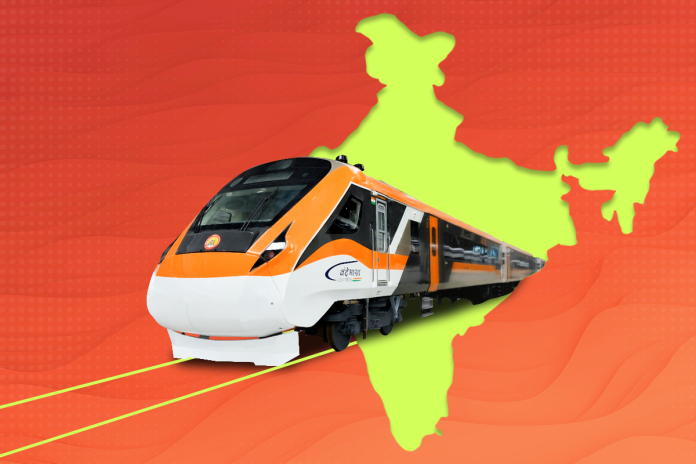The year ending for 2023 was marked with the introduction of six new routes of the Vande Bharat express, at the launch ceremony held in Ayodhya on 30 December.
This expansion also included a new Vande Bharat connecting the temple town Ayodhya with Delhi — as part of enhancing connectivity options in anticipation of the increased religious tourism expected with the opening of the Ram Temple on 22 January.
This recent expansion brings in a total of 40 operational routes of the semi-high speed train, running across several important cities and towns in the country.
Of the total network, Indian Railways introduced 32 new routes during 2023 alone, keeping up with its commitment to improve passenger experiences, and advancing railway infrastructure.
The network now covers more than 15,000 km, connecting not just economic centres but also prioritising rapid connectivity to several destinations of religious significance and actively contributing to the country’s flourishing religious tourism.
Enhancing Connectivity To Religious Sites
Improving connectivity to pilgrimage sites and elevating local economies stand as focal points in the government’s promotion of Vande Bharat Express trains.
Among the six newly launched routes, three routes link pilgrimage destinations — connecting Delhi with Amritsar, Ayodhya, and Vaishno Devi in Jammu.
A closer look at the existing routes of the expansive network also reveals improved connectivity between revered religious sites and surrounding economic centres — such as Tirupati, Shirdi, Madurai, Puri Jagannath, and Varanasi.
Here’s how the Vande Bharat network map looks now.

Furthermore, following the occupancy data per several reports in 2023, many of these routes have operated at satisfactory or higher demand levels.
The Varanasi-New Delhi route was noted to have occupancy of 128 per cent, whereas the Vande Bharat between Mumbai and Shirdi was noted with occupancy rates between 80 to 90 per cent.
In addition, due to the heightened demand, three Vande Bharat routes now operate with two trains in service.
Of the three, two are the Delhi-Varanasi and Delhi-Vaishno Devi routes, which have experienced high passenger demand fuelled by the rising number of pilgrims visiting these destinations.
This also reflects a shift in passenger preferences toward rail transport due to faster travel, better facilities, and the rising interest in religious tourism.
Religious Tourism Growth In India
The improved connectivity not only facilitates pilgrims’ travel but has also resulted in increased development, elevating the local economy and creating job opportunities.
India’s religious and spiritual tourism sector is experiencing an extraordinary surge in visitors.
Recently, Ritesh Agarwal, the CEO of OYO rooms, also shared an insight observed on 31 December — an 80 per cent surge in users searching for accommodations in Ayodhya.
Further, Ayodhya witnessed a 70 per cent spike in app users, while Goa and Nainital stood at 50 per cent and 60 per cent, respectively.
In 2022, domestic pilgrim visits tallied 1,433 million, growing from the 677 million recorded in 2021. Similarly, foreign tourists exploring these spiritual sites surged to 6.64 million in 2022, up from 1.05 million in the previous year.
Enhanced connectivity initiatives and upgraded facilities have played pivotal roles escalating the trend of religious tourism in India.
Better connections, like the Vande Bharat Express, are helping this trend grow.
Looking at 2024, it seems like religious tourism will keep on getting popular across the country, supported by the continuous expansion of the Vande Bharat network connecting more such significant locations.


